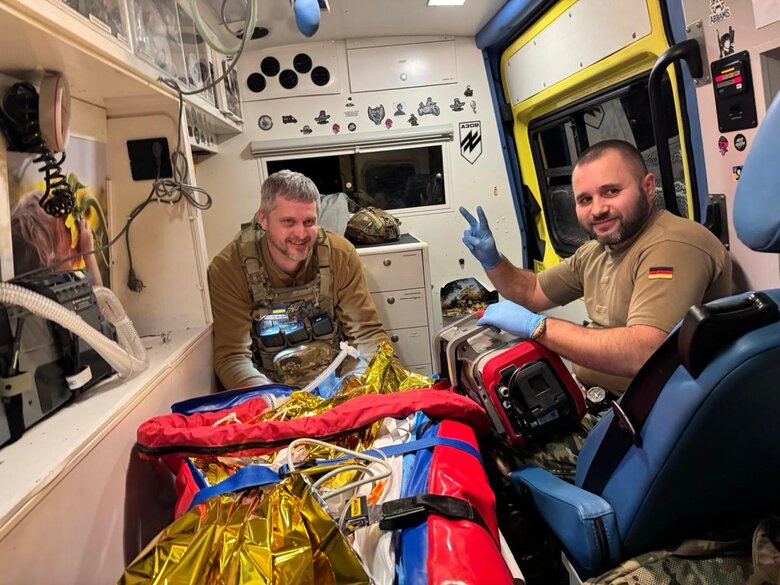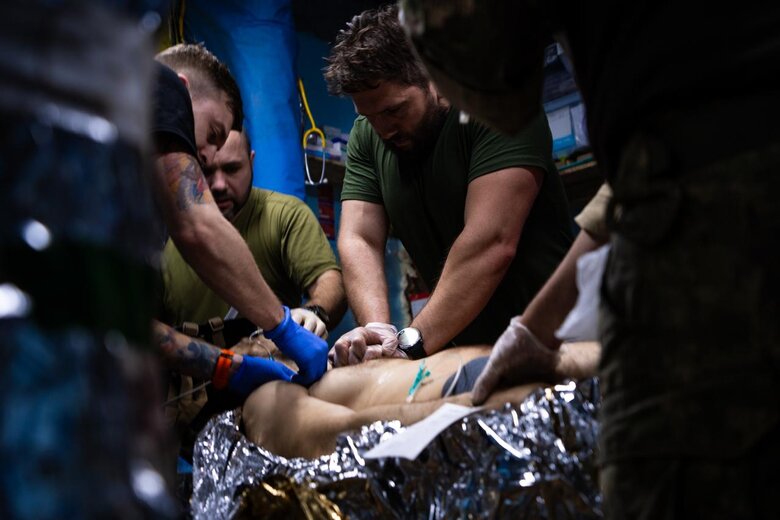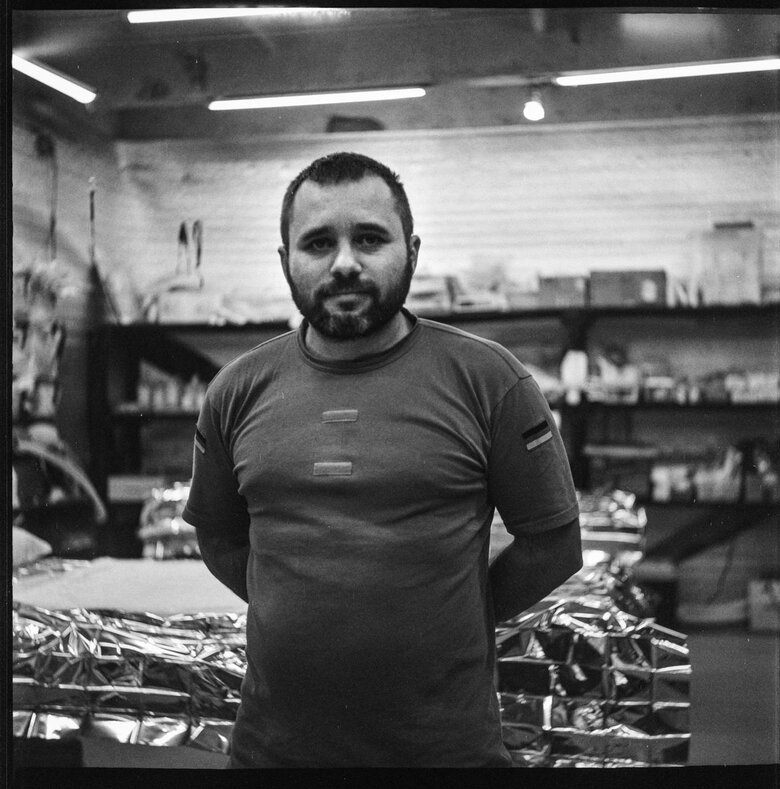Evacuating wounded is complex artistic quest. War of drones and artillery does not always allow you to take wounded, even with 5-10 crews, - "Azov" medic Mykhailo Isak
In June this year, the government "improved the mechanism for targeted medical evacuation of military personnel who have suffered injuries, traumas or illnesses as a result of armed aggression by the Russian Federation". This means that from now on, the practice of transporting wounded or sick soldiers from the battlefield or dugouts to their final treatment destination within 48-72 hours will be extended to the entire army.
The actual model of rapid delivery of a military patient to the end point was developed and applied by the 12th Special Forces Brigade "Azov" together with the Superhumans clinic and the Ministry of Health.
In an interview with Censor.NET, "Azov" military medic Mykhailo Isak (Anest) spoke about the beginnings and reality of targeted evacuation. The 37-year-old soldier is originally from Zakarpattia, has lived in Dnipro for a long time and worked as a paediatric anaesthetist at the Regional Children's Clinical Hospital before the full-scale invasion. He admits that now, despite continuing his medical profession, he no longer associates himself 100% with civilian doctors.
According to him, the targeted evacuation, thanks to a clear mechanism and speed, allowed him to save limbs and save a large number of Azov soldiers from death.
THERE ARE A LOT OF CASES WHEN A SOLDIER CHANGES 3-4-5 OR MORE HOSPITALS BEFORE THE END POINT OF TREATMENT
- I enlisted in April 2022 as a soldier in the Luhansk Territorial Defence Forces, as it turned out later. However, I did not know where I was going, I was completely unfamiliar with military matters – I just went to the military registration and enlistment office.
I was a paramedic at a medical point for over a year. I went through Zolotarivka, Bilohorivka, Torske and Serebrianskyi forest. After being withdrawn, I entered the Ukrainian Military Medical Academy, where I received a military rank. I think it was the first sergeant's course, after which you could get an officer's rank. From there, I was assigned to the Donetsk TDF, where I was in charge of the evacuation process. But before that, I had already applied to "Azov", and they quickly contacted me. The documents were processed quite quickly, and in November 2023, I was transferred to the medical company of the 12th Special Forces Brigade "Azov".
- What was your motivation back in 2022?
- I thought what everyone else did: I had to do something to prevent the war from coming to my home. Honestly I joined in April, even though I could have avoided it. The thought of staying at home did not give me peace. I do not regret my choice and will not regret it, I am proud to be here. For a long time, I have not been associating myself with the military, and now I no longer associate myself 100% with civilians. On the other hand, it's very difficult for my family, because my wife, son, and parents understand that it's unknown when I will return.
- Did you join as a combat medic?
- No, I started serving there as a paramedic.
The vast majority of the community confuses two completely different concepts - "combat medic" and "military doctor". A combat medic may not have a specialised medical education. This is a person who has undergone combat training and medical courses and has the knowledge to provide adequate care in accordance with international standards (TCCC, MARCH). And when he has the level of CMC, he can be placed in the position of a combat medic - providing assistance in conditions of limited resources. This course is quite short, but successful, because it works according to a certain NATO algorithm.
Medical education is at least 3-4 years, if we are talking about a nurse or paramedic. A doctor takes 6 years, plus an internship of 2-3 years.
- Do you remember how the idea of targeted evacuation came about?
- In the ranks of our brigade, it started with certain conversations and talks about the need to improve the process of evacuating the wounded. We thought for a long time about how to do it right, and planned a route through hospitals. Then our team met the Superhumans clinic, our first partner with whom we have been working most closely so far, and the first targeted evacuations were carried out with them. That is, we evacuated patients from the frontline surgical team to their clinic in Lviv Oblast.
This allowed us to at least save the limbs of several patients with very severe cases. Today, they have their own limbs and have retained grasping function in their hands - these were the most difficult cases we have had. We have also encountered muscle and bone defects that were accompanied by high risks of amputation, but due to the fact that these patients were brought to the point where they receive the full range of surgical care as quickly as possible, both the treatment and rehabilitation periods are significantly reduced. If these servicemen can return to service, they do so faster, and if not, they recover faster. In addition, it is better for their psychological state and, in one way or another, it saves the state money, because instead of a year, treatment takes 5 months.
- Have you personally encountered cases when time was lost and the wounded lost a limb or achieved much worse results in treatment?
- Unfortunately, there are a lot of such cases now in the context of the drone war, because evacuation from the front line is most difficult. Where it was possible to save the limb, this does not happen due to the loss of time. However, it's not just that some stage of evacuation is delayed. As a rule, they try to provide the most effective assistance at all stages, but it is not always possible to achieve this in terms of resources.
If a wounded soldier is admitted to an frontline surgical team for primary stabilisation, the people working there do their best. Unfortunately, they have been through a lot of people, so they know what they do. However, there are a lot of cases when a serviceman reaches the last point of medical care for the full range of treatment, sometimes he goes through 3-4-5 or more hospitals. And even if there is no risk of amputation, each hospital has its own flora, schedule of medications and bandages. A soldier could be brought in at 4 p.m. and bandaged at 8 a.m. That is, time can be lost in this chain, and 100% of it is lost.
Plus, resources, especially in frontline hospitals, are limited. Not because the hospital is bad, but because the closer you are to the front line - Kharkiv, Dnipro - the larger the pool of patients that go through the doctors. That's why they are really swamped.
Therefore, if possible, we need to avoid clinics that are maximally loaded and give the patient the point where treatment can be carried out effectively within the next 48-72 hours.
ALL HOSPITALS WE HAVE CONTACTED ARE FRIENDLY
- Previously, the distribution of the wounded as part of a targeted evacuation was based on agreements with specific hospitals. This proved to be effective for one or several teams. What are the risks that this will stall throughout the army?
- One way or another, it will get stuck, because before you send a patient to a hospital, you need to agree it with the end point - hospital X. You need to agree on the nature and severity of the injury, readiness for transportation, and the availability of free beds in the hospital. That is, there is a communication process, and only then does the patient go to the final destination.
All the hospitals we have contacted and are in contact with are absolutely friendly to us in terms of getting the wounded into their hands as soon as possible. And they are interested in doing their own work, not redoing someone else's.
- How satisfied are you with the way the profile of the hospital to which the patient is to be taken is determined correctly and quickly? Now it is the "Ukrainian Scientific and Practical Centre of Emergency Medical Care and disaster medicine of the Ministry of Health of Ukraine" that has to do this.
- It is very difficult to say. This is a way of working that has just begun. However, the "emergency" service is making a very big contribution in this matter. They are interested, they work, they take patients. And we send not only the wounded but also chronic patients. Everything has always been agreed quickly and on time.
Everything will not be perfect from the very first days. It is important to understand that this cannot be built in one day. "Emergency" works as actively as possible in this format. How well do they identify establishments? At this stage of my life, it's hard to say, because if I were ill, I would want to be treated in a mega-class clinic, and everyone has such desires. But the institutions for treatment are determined by order. I see good prospects, and after a while everything should be scaled up.
- The aim of the programme is to deliver the patient to the final place of treatment in 48-72 hours. Why is this interval important?
- This is considered a light period in terms of contamination with bacterial flora. This is especially important for patients with musculoskeletal trauma and other severe injuries, such as thoraco-abdominal (chest and abdominal injuries - Ed.), but is not always achievable. We understand that sometimes a patient needs to be stabilised, which usually takes 24 hours. The way things are working now, most patients who were subjected to targeted evacuation reached their final destination within a day, which is much faster than 48 hours.
- How important is the pre-hospital period in this chain? I guess that part is sagging the most since there aren't enough combat medics in many brigades.
- There is a real shortage of them, and there is a shortage in all brigades. But the point is the complexity of the evacuation itself. The war of drones and the war of artillery does not always allow you to take the wounded from the point where he is, even with 5-10 crews. After all, evacuation must be safe for both the patient and the evacuating team. Vehicles, even armoured ones, cannot always reach the point where the wounded is located. That's why evacuating the wounded is now a complex artistic quest. The people who do it invent a lot of means to ensure that wounded guys or girls on the battlefield survive and keep their health as much as possible.
- The overall picture is complicated by the work of enemy drones and artillery. The Russians target the evacs, but on the other hand, they do not allow them to get close?
- Any vehicle that appears in the area of impact will be hit. It doesn't matter whether it is medical or not. Therefore, everything depends on the conditions, including day and night, weather conditions. In general, it is a big team effort. Sometimes a single evacuation flight is an art form.
TARGETED EVACUATION REACHES A LEVEL WHEN A BRIGADE WILL NOT BE INVOLVED
- Do you communicate with other brigades on this topic? What are their challenges? I suppose there are more obstacles and problems there than in the brigades that everyone is used to looking up to.
- I have not had a chance to communicate with colleagues from other brigades. Now the targeted evacuation is getting and may eventually reach a level where the brigade is not entirely involved. The centralised process starts a little bit higher than the brigade - with the frontline surgical group or department (this is ROLL2), which provides more assistance than at the stabilisation point. After that, the patient can be staged over a long distance (although not necessarily a targeted evacuation - it's about long distances). This is not managed by the brigade. It can be involved, can be involved in the processes and assist in the routing of its fighters.
- Give us an example of real cases when targeted evacuation helped to save people's limbs or even lives.
- Let's take two types of patients. Six months ago, we had a patient with a thermal injury, about 60% of burns, and a fractured tibia. He was in serious condition and was receiving first aid at the stabilisation point. Then, from the frontline surgical group, he was transported to the Dnipro Clinical Hospital (now Hospital No. 16). There, after stabilisation measures, we took the patient within 48 hours and got him to the point where he was to receive final treatment - the burn centre of the Pirogov Hospital in Vinnytsia. There, the patient has been treated for about a month, and then, under the Ministry of Health programme, he was sent for treatment abroad. And now this patient already runs. I saw a photo of him playing football with a crutch, and all his burn injuries have healed.
The second patient, I have been helping him from the very beginning. I managed to evacuate him from the place where he had been wounded. We brought him to the stabilisation point, did everything necessary and sent him to the frontline surgical group. There he was fitted with an external fixation apparatus. The patient was seriously injured, he was undergoing artificial lung ventilation and heart support. From there, he was sent to Mechnikov Hospital in Dnipro, where, when he was stable, the endotracheal tube was removed and then transported to the Superhumans clinic. He is now undergoing rehabilitation. Unfortunately, he has a long way to go in rehabilitation and cannot be fully cured: he is missing about 20 cm of his humerus. Nevertheless, thanks to advanced surgical techniques, he underwent transplants of bone and a flap of muscle and skin. He can move his arm and serve himself. Yes, not fully, but the arm works. And it is his own, which is very good.
Olha Skorokhod, Censor.NET



